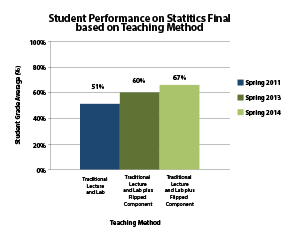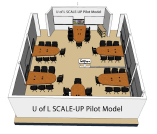
by Victoria Holec
Analytical Assistant, Learning Environment Evaluation Project (LEE)
Over the past 12 months, the term SCALE-UP has surfaced on multiple occasions throughout our campus. It was first introduced to us as part of the consulting process for the Destination Project’s new academic building, of which many faculty members across all departments have been a part. In fact, it may have been at one of those consultation meetings that you first heard the term SCALE-UP. This article provides a brief introduction to what SCALE-UP is, and will conclude with some exciting news for you!
How SCALE-UP became what it is now
SCALE-UP now most commonly stands for Student-Centered Active Learning Environment with Upside-down Pedagogies. It originated in the late 1990s at North Carolina State University with Robert J. Beichner. SCALE-UP is derived from studio physics and was meant as an initiative to bring an active learning environment to large introductory classes in the STEM (science, technology, engineering, and mathematics) disciplines. The SCALE-UP initiative showed a plethora of successful outcomes for students, such as improving grades, reducing failure rates, fostering better conceptual understanding, improving problem-solving skills, and improving student attitudes toward introductory STEM classes (Beichner, 2008; Beichner, Saul, Allain, Deardorff, & Abbott, 2000; Beichner et al., 2007). In particular, failure rates of female students in these science courses are cut in half and those of visible minorities are cut by a factor of four. SCALE-UP also eliminates the back-of-the-room phenomenon, according to which high-achieving students sit in the front, and poor students sit in the back of the class (Miller Kregenow, Rogers, & Price, 2011). While SCALE-UP originated in science and engineering, it has now been used with a variety of subjects, including business, astronomy, and literature.
A teaching approach…
First and foremost, SCALE-UP is a pedagogy or teaching style. If you look closely at the elements of its name, you will see why. First, SCALE-UP engages students in active learning. Active learning happens when the responsibility of the learning is with the learner rather than with the instructor. Second, SCALE-UP assumes an upside-down pedagogy, which is also commonly known as flipped teaching. That means that content is delivered to students outside of and prior to class, while in-class activities centre on hands-on problem solving. The instructor serves more as a guide on the side rather than the sage on the stage. Another big part of the SCALE-UP pedagogy is classroom management. Students collaborate in teams of three or in larger groups of six or nine. Roles within the teams are carefully assigned at the beginning of class to maximize student participation. These roles include the team manager, the recorder, and the critic, and they typically rotate throughout the term. Student activities are divided into tangibles, which are shorter hands-on exercises that students should be able to answer based on their preparation, and ponderables, which are more challenging activities in which students apply what they have learned at a higher level. For courses such as physics and engineering, SCALE-UP eliminates a separate lab component, as this approach intrinsically integrates lab and lecture with active, hands-on learning occurring in class, and content delivery happening before and outside of class.
…plus a learning environment
SCALE-UP as a teaching style is really facilitated by a classroom environment that encourages this approach to teaching. Beichner’s team designed the first SCALE-UP room at NCSU that has since become the exemplary framework for anyone implementing or adapting SCALE-UP. A typical SCALE-UP room has round tables that sit nine students each. Thus, each table sits three teams, which are labeled A, B, and C. Tables are further numbered, so each team can be easily identified (e.g., 4C = Team C at Table 4). This allows for splitting the room into thirds using team number, or in half using table number (odd/even). More recently, smaller SCALE-UP-type rooms have grouped their teams around tables of six students, often due to smaller class sizes. Round tables easily facilitate collaborative activities among students. In a SCALE-UP classroom, there is no front of the room. The instructor station is typically located in the centre of the room, and the instructor spends most of the class time circulating among students. Students usually have access to one projection screen per table to display materials, as well as ample whiteboard space to record activities or work through problems. Importantly, if the teaching style and the learning environment don’t match, SCALE-UP is minimally successful (Lasry, Charles, Whittaker, Dedic, & Rosenfield, 2013).
But what if I’m not good with technology?
While SCALE-UP classrooms are often technology heavy, it is entirely optional to use it. Technology is considered as more of an organizing feature that allows for the web-based aggregation of resources such as activities, calendars, syllabus, lab reports, and notes. Beichner himself describes that the tables in the room are actually the most important technology. From reading SCALE-UP adopter reports, it seems that the most common teaching technology used in these rooms is the whiteboard. Traditionally, each team of three students has access to a laptop that is stored in the classroom. The ideal situation is that each table has a projection medium, such as a data projector or an LCD screen, to which students can project materials from the laptops. The instructor has the ability to project his/her content to all the screens in the room, and to project any single student laptop to all screens as well. This facilitates sharing interesting findings or even unforeseen problems with the entire class. The Learning Environment Evaluation (LEE) Project in conjunction with the Teaching Centre is happy to provide training workshops for instructors interested in learning how to use this technology.
SCALE-UP is coming to the U of L!
As part of the planning for the Destination Project new academic building, LEE has been asked to evaluate the effectiveness of a SCALE-UP room on campus. After an extensive planning process, a SCALE-UP room was built at the UofL during the summer of 2014. Because this room has to be accommodated in an existing space, the capacity will be for 36 students. Do you want to try out a session, module, or component of your course in the SCALE-UP approach? We’re looking for volunteers to pilot this exciting project with us. If you have a single lesson or a few that you would like to teach the SCALE-UP way in a SCALE-UP classroom, let us know! If you want to take the leap of faith and convert your entire course into a SCALE-UP course, we’d be more than happy to support you all the way from course design to implementation.
Some ponderables for you
So you think this SCALE-UP idea is neat, but are not sure if it would work for your course? Here are some questions for you to consider in thinking about your specific class:
How do I foster student engagement?
How do I flip my course?
How do I teach without a front of room?
What kind of teaching support do I need?
How do I manage student teams?
Contact one of our teaching development facilitators for ideas on how to convert your course into a SCALE-UP course. Check out the LEE project website at http://uleth.ca/teachingcentre/lee/what-is-scale-up for more information and resources. The LEE project is an initiative of the Teaching Centre.
Figure 1IT’S FLIPPIN’ HAPPENING! In the Spring 2013 semester, Dr. Harold Jansen (Board of Governors Teaching Chair, Professor of Political Science) decided to flip the statistics section (about 50%) of his second-year Introduction to Research Methods course as an experiment to change up his teaching. Little did he know how successful this teaching approach would be! Compared to previous courses, performance on the statistics part of the course increased by 30%, and he reports that students had a much better understanding of the material. LESSONS LEARNED: Harold reports that it took him 20-25 hours each week to prepare a flipped session. This included him recording a screencast with animations and voiceover, editing the recording, and uploading it to the Internet. However, the investment led to a tremendous payoff, and Harold would do it again without thinking twice. |
 |
CHALLENGES MASTERED: Harold recalls that for the first flipped session, there were a few students who had not watched the assigned video prior to class. However, students quickly realized that he would not spend class time to explain the material again, and that they fell behind with the in-class activities. “Before the second class, everyone had watched the video,” Harold remarks with a smile. ADVICE FOR YOU: Harold emphasizes that flipped teaching and content delivery outside of class will never replace the instructor. He says he has never spent so much time with individual students in class and was therefore able to address specific needs. Harold is happy to answer any questions about his experience with flipped teaching via e-mail at harold.jansen@uleth.ca. |
Figure 2SCALE-UP PILOT CLASSROOM. As part of the exciting classroom planning for the Destination Project, the LEE in conjunction with the Teaching Centre, has proposed to build a pilot SCALE-UP room at the U of L. As of April 2014, the funds for this project were officially granted and LEE is thrilled! This room will serve as grounds for practice and research around SCALE-UP. Some of us were told that we need such a room on campus, but barely anyone has ever taught the SCALE-UP way. It is LEE’s objective to find out how this room will work for those teaching SCALE-UP, and possibly adapt it to make it into something that fits with the teaching culture at the U of L. |
 |
WHAT’S IN THE BOX? The pilot room will be adapted from a traditional SCALE-UP room. Because it has to be retrofitted into an existing space, the room can only accommodate a maximum of 36 students. Students will sit as teams of three in their larger groups of six around six trapezoidal tables with rounded edges facing the centre of the room. Each table has access to a large LCD projection screen and ample whiteboard space to produce and record work. The instructor station is located in the centre of the room. The extra chair per table is optional and mainly intended for an instructor or teaching assistant to discuss activities with students. This pilot room will inform the planning of SCALE-UP or SCALE-UP-type rooms in the future. |
References
Beichner, R. J. (2008, September). The SCALE-UP project: A student-centered active learning environment for undergraduate programs. Invited white paper for the National Academy of Sciences.
Beichner, R. J., Saul, J. M., Abbott, D. S., Morse, J. J., Deardorff, D. L., Allain, R. J., Bonham, S. W., Dancy, M. H., & Risley, J. S. (2007). The student-centered activities for large enrollment undergraduate programs (SCALE-UP) project. In Redish & Cooney (Eds.), Research-Based Reform of University Physics, College Park, MD: American Association of Physics Teachers.
Beichner, R. J., Saul, J. M., Allain, R. J., Deardorff, D. L., & Abbott, D. S. (2000). Introduction to SCALE-UP: Student-centered activities for large enrollment university physics. Presented at the Annual Meeting of the American Society for Engineering Education, Seattle, WA, Session 2380.
Lasry, N., Charles, E., Whittaker, C., Dedic, H., & Rosenfield, S. (2013). Changing classroom designs: Easy; Changing instructors’ pedagogies: Not so easy…. AIPR Conference Proceedings, 1513, 238.
Miller Kregenow, J., Rogers, M., & Price, M. F. (2011). Is there a “back” of the room when the teacher is in the middle? Journal of College Science Teaching, 40(6), 45-51.